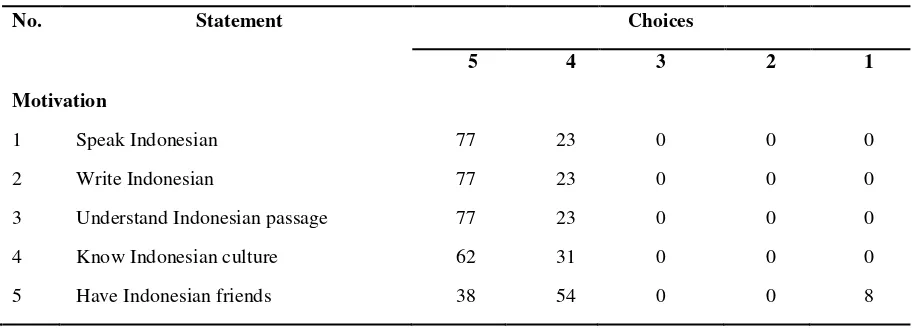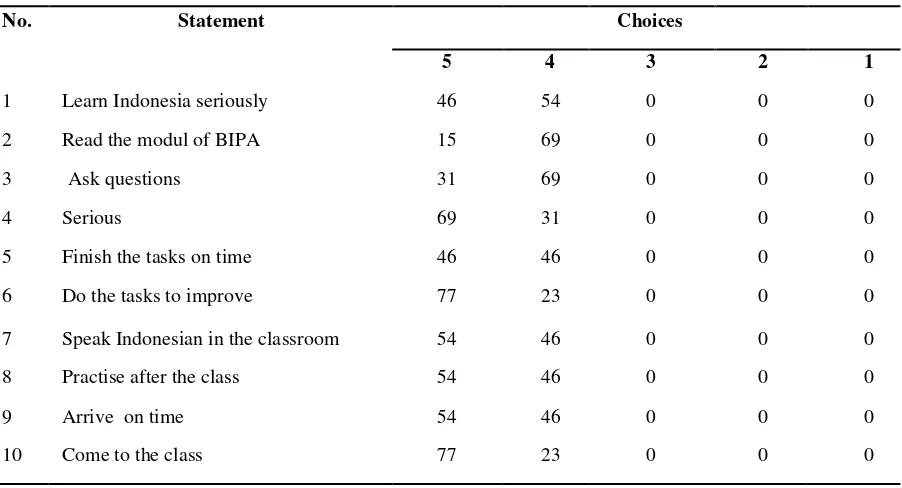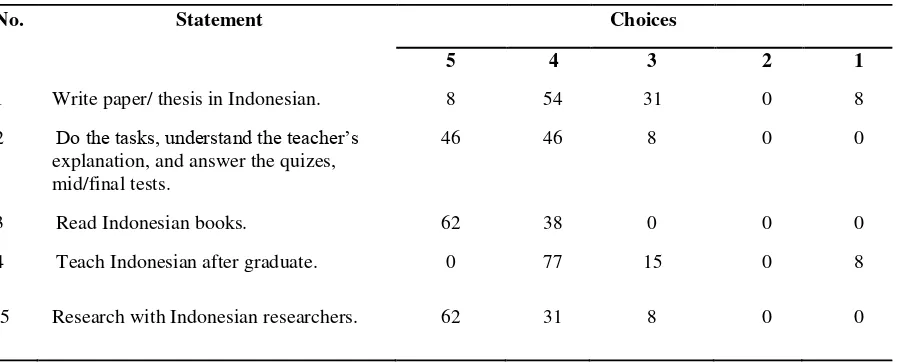Understanding the Motivations, Attitudes, and Expectations of Foreign
Speakers Learning Indonesian
Krishandini
Endang Sri Wahyuni
Hesti Sulistyowati [email protected]
Bogor Agricultural University, Indonesia
Abstract
Learning Indonesian for foreign speakers (BIPA) is a course which has been carried out by the government and various private institutions in Indonesia. Bogor Agricultural University (IPB) offers BIPA courses for IPB students who learn at the level of S1 and S2. Learners doing the BIPA courses at IPB are dominated by IPB students who have to take a one-semester course before attending classes. This is because college classes are more likely to use Indonesian than any other language.
In this study, the following questions were investigated: 1) What were the real motivations of the foreign students who take BIPA?, 2) What were their attitudes towards BIPA learning? and, 3) What are their expectations after completing BIPA study?
The population of this research was foreign students who study Bahasa Indonesia at IPB. The data were collected through questionnaires and observations. BIPA students have a positive motivation to participate in BIPA learning, have a good attitude to learning, and hope to be able to teach Indonesian when they return to their home countries.
Introduction
Foreign students learning Indonesian in Indonesia (called BIPA, Bahasa Indonesia untuk penutur asing) at Institut Pertanian Bogor (IPB) are prospective students for admission to IPB through the IDB (Islamic Development Bank) and KNB (Kemitraan Negara Berkembang) – Partnership of Developing Country. Before these students are permitted to enroll in their department or major subjects, they have to attend Indonesian classes for one semester. This is intended to help them understand the lessons given by the professors. The mastery of Indonesian for them is very important because Indonesian is used as the instructional language in every university in Indonesia. This is in accordance with the government regulation Number 4, Article 29, Paragraph 1, 2009, where it is stated that Indonesian is to be used as the language of instruction in the system of national education in Indonesia.
Research objectives
There are three aims of this research:
1. To know the real motivation of BIPA students in learning Indonesian. 2. To understand the attitudes of BIPA students when they learn Indonesian. 3. To know the students’ expectations after they finish learning Indonesian.
Method
This research is quantitative analytical descriptive research. The participants in this study are BIPA students at IPB. They are foreign students accepted through the KNB track. The researchers grouped the students based on the entry year, i.e. from 2012 to 2014. This research was carried out in April-June, 2015.
Literature review
Brown (2008) said that motivation can take the form of global, situational, or task oriented. Learning a foreign language uses these three levels of motivation. In this study motivation was examined in accordance with intrinsic and extrinsic motives. Intrinsic motivation is motivation caused by factors coming from within oneself or attached to a task that is still being done. Extrinsic motivation is motivation caused by external factors and is not related to any task (Ormrod, 2008).
Motivation is energising. This means that it directs and sustains the students. A student’s
motivation is considered an individual investment, having cognitive, emotional, and attitudal
implications with the school’s involvement (Fredricks & Blumenfeld quoted in Ormrod,
2008). Motivation is the result of interaction among three factors: rewards; performances that can produce something expected; and an asumption that achievement will create something. Meanwhile, attitude is a pattern of behaviour and can be adjusted in social situations. Attitude is affective, and can be positive or negative.
Results
The results concerning motivation, attitude, and expectation for BIPA students are presented in the following table:
Table 1. Students’ motivation in learning BIPA lesson (%)
No. Statement Choices
5 4 3 2 1
Motivation
1 Speak Indonesian 77 23 0 0 0
2 Write Indonesian 77 23 0 0 0
3 Understand Indonesian passage 77 23 0 0 0
4 Know Indonesian culture 62 31 0 0 0
5 Have Indonesian friends 38 54 0 0 8
From Table 1, it can be concluded that the motivation of BIPA students in learning BIPA lessons is very high. As mentioned in the introduction, IPB BIPA students are foreign students who come to Indonesia for the first time. They have neither heard nor spoken Indonesian previously. This increased their motivation to speak Indonesian in their daily life. The results show that 77% of IPB BIPA students strongly agreed that they wanted to be able to speak, write, and understand Indonesian, while 23% of them agreed.
Mastering a language relates not only to speaking, writing, reading and listening, but also to understanding the society and culture of the native speakers. This drives respondents to learn Indonesian enthusiastically. Most of the respondents agreed that they learnt Indonesian so they could make many friends in Indonesia. However, 8% of respondents strongly disagreed with that statement. BIPA students at IPB have very good ability in communicating in English.
Students with high motivation after they had BIPA lessons found their attitude was significantly influenced also. This can be seen from the following table.
Table 2. Students’ attitudes towards BIPA learning (%)
No. Statement Choices
5 4 3 2 1
1 Learn Indonesia seriously 46 54 0 0 0
2 Read the modul of BIPA 15 69 0 0 0
3 Ask questions 31 69 0 0 0
4 Serious 69 31 0 0 0
5 Finish the tasks on time 46 46 0 0 0
6 Do the tasks to improve 77 23 0 0 0
7 Speak Indonesian in the classroom 54 46 0 0 0
8 Practise after the class 54 46 0 0 0
9 Arrive on time 54 46 0 0 0
10 Come to the class 77 23 0 0 0
Explanation: 1=Never; 2=Rarely; 3=Often; 4=Very often; 5=Always.
From Table 2, the data shows that the attitudes of IPB students towards BIPA were positive. Most stated that they learned Indonesian with all their heart.
Fifteen percent of respondents said that they always read the module that had been prepared by IPB, while 69% said that they often read it, and only 8% said that they rarely read it.
Thirty-one percent of respondents said that they always asked when they did not understand the subjects. This was supported by 69% who said they often asked.
not answer. As many as 77% of BIPA students who were also respondents in this research said that they always did the tasks to improve their ability in Indonesian. Moreover, 23% of respondents said that they often did the tasks.
In this BIPA learning and teaching, 54% of respondents said that they always used Indonesian and 46% of respondents said they often used Indonesian in the classroom.
Outside the classroom, 54% of respondents said that they often practised speaking and writing, while 54% of respondents said that they always came on time and 46% of respondents said that they often came on time. Therefore, 77% of respondents answered that they always came when they learnt Indonesian and 23% of respondents said that they often came.
The expectations of BIPA students at IPB was based on Vroom’s concept. According to Vroom, motivation is the result of interaction among three factors: how large is the desire of a person to get a reward; the deed or effort that always produces something; and estimation that achievement will produce acquisition (Jamaris, 2010).
Table 3. Students’ expectations attending BIPA class (%)
No. Statement Choices
5 4 3 2 1
1 Write paper/ thesis in Indonesian. 8 54 31 0 8
2 Do the tasks, understand the teacher’s 46 46 8 0 0
explanation, and answer the quizes, mid/final tests.
3 Read Indonesian books. 62 38 0 0 0
4 Teach Indonesian after graduate. 0 77 15 0 8
5 Research with Indonesian researchers. 62 31 8 0 0
Explanation: 1=strongly disagree; 2=disagree; 3=doubt; 4= agree; 5=strongly agree
From Table 3, it is shown that expectations of BIPA students at IPB is very high. They expected that after attending BIPA classes, they could write a paper in Indonesian. Their expectation was that they wanted to be able to do the tasks, understand the explanation of the teacher, answer a quiz, and mid and final tests in Indonesian.
Most respondents answered that they expected to be able to teach Indonesian after they graduated from IPB. They said that they could either work as an employee with the educational background that they have, or teach Indonesian to the people in their own country. However, 15% of respondents doubted they would be able to do this. Most also hoped that they could work with Indonesian researchers.
Table 4. External factors in BIPA learning and teaching (%)
No. Statement Choices
5 4 3 2 1
External factors
1 Facilities and infrastructure 54 31 15 0 0
2 Learning time 46 54 0 0 0
3 Lecturer 46 46 0 0 8
4 Teaching method 38 54 8 0 0
Explanation: 1=strongly disagree; 2=agree; 3=doubt; 4= agree; 5=strongly agree.
From Table 4, it can be seen that eighty-five percent of respondents said that the facilities and infrastructures were very adequate or adequate. However, 15% of respondents did not think the facilities and infrastructure provided for learning and teaching was not supported by multimedia.
All respondents said that the time allocated for learning and teaching Indonesian was suitable or really suitable.
Over 90% of respondents agreed that the lecturers teaching BIPA at IPB really supported the students patiently and kindly.
The respondents really agreed that the activity of BIPA learning at IPB was supported by good performance from the lecturers because they used interesting methods that could attract
students’ interest. Learning and teaching used in BIPA at IPB emphasised communicative
learning and teaching methods, and over 90% of respondents thought that this was appropriate.
Conclusion
BIPA students at IPB have a high motivation to learn Indonesian. They have both external and internal motivation. They want to be able to speak, write, and understand Indonesian texts. They agreed that they wanted to be able to teach Indonesian in their country after they graduated from IPB. Positive attitudes were shown by BIPA students at IPB. BIPA students have a high motivation to attend the BIPA lessons because of the adequate facilities and infrastructures. Moreover, the activity of BIPA learning and teaching was supported by good
performances by the lecturers. They used interesting methods that can attract students’
interest to learn Indonesian.
References
Azwar, Saifuddin. (2003). Sikap Manusia. Teori dan Pengukurannya. Yogjakarta: Pustaka Pelajar.
Hoy, Anita Woolfolk, & McCune-Nicolich, L. (1984). Educational psychology for teachers. Englewood Cliffs, New Jersey: Prentice-Hall.
Jamaris, M. (2010). Orientasi Baru dalam psikologi Pendidikan. Jakarta: Yayasan Penamas Murni.
Ormrod, J. E. (2008). Educational psychology: Developing learners. [N.J: Prentice Hall].
Psikologi Pendidikan. Membantu Siswa Tumbuh dan Berkembang. Kumara Amitya,
penerjemah. Jakarta: Erlangga.
Appendix
Understanding the motivations, attitudes, and expectations of foreign speakers learning Indonesian
Sex 1. Male
Direction: Put cross (X) within the column whether you: Strongly agree; Agree; Doubt; Disagree; Strongly
disagree.
Questionnaire A. Students’ motivation in learning Indonesian
Questionnaire B. The attitudes of foreign students towards Indonesian teaching and learning
Questionnaire C. The expectations of foreign students towards Indonesian learning



